 Seraphic College
Seraphic College
The convent of San Giovanni Rotondo included a small seminary called “Seraphic
College”. Padre Pio was assigned the direction, including spiritual direction,
and some teaching.[1]
Aurelio Di Iorio da Sant’Elia a Pianisi studied under Padre Pio from 1916 to
1918. Padre Aurelio reported: “He had a superficial way of teaching. He taught
history and grammar, but he knew little of the former and none of the latter.
None less we boys were attracted to him. The key to his charm was his humanity.
His sanctity was his humanity.”[2]
Paolino also was his student: “He had weekly conferences were he introduced us
to the love of the Lord.”[3]
Padre Pio was so committed to help the student that he wrote to Padre Benedetto
on March 6, 1917: “I have a vivid desire to offer myself as a victim for
perfecting this college that I love tenderly.”[4]
Federico Carrozza da Macchia Valfortore, another student at the time: “He was
always praying, night and day. In our midst, while talking to us, he held the
rosary in the right hand, hidden in the folds of his habit. He spent long hours
on his knees. In the refectory he took a few mouthfuls.[5]
Aurelio reported that he and the other students in the seraphic college one
morning saw Padre Pio’s bed completely turned upside down and twisted. Also, the
curtain and the rod holding the iron curtain were all twisted up like a piece of
curly hair. The rod was thick as a finger, and was all turned and twisted. “We
were really scared.” When Padre Pio came along and saw the devastation, and the
students scared, he said: “Don’t make a big deal of it. Barbablu’ messed up
everything.”[6]
July 29, 1918: “It has been a week that I have been alone with the students,
because Padre Paolino is out. I hope that he will come back this evening. He
will leave again on Saturday.”[7]
In September 1918 the Spanish fever was still raging in Italy. In those few
weeks 200 people had died of Spanish fever in San Giovanni Rotondo.
[8]
In the college, the two dozen or so boys were almost all ill. The doctor
prescribed injections. Because he was understably overworked, he thought Padre
Paolino and Padre Pio how to give the injections. Since alcohol was not
available, the doctor left some carbolic acid to sterilize the site of the
injection.[9]
Padre Pio obtained “secretly” through Maria De Vito from her cousin Valentino Vista, a pharmacist in Foggia a little bottle with four grams of pure carbolic acid “for the disinfection of the syringes and also four grams of veratrine.[10]
Towards the end of June 1920, Mons. Salvatore Bella, bishop of Foggia, took to the Holy Office the deposition of the two pharmacists who feared Padre Pio was artificially causing the stigmata with the aforementioned drugs.[11]Padre Pio explained it under oath to Mons. Rossi: “The secret was requested to conceal from those who would transport it that it was a dangerous medicine, without a doctor’s prescription. The purpose was to disinfect he syringes. In a boarding school for boys there is often such necessity.”[12]
About the veratidine Padre Pio testified: “I requested it because Padre Ignazio
made me sniff once such powder. I wanted to use it during recreation. A small
dose of this powder prompts immediate sneezing.”[13]
Padre Pio’s family had also been stricken. On September 22 died Padre Pio’s
nephew Pellegrino, and on September 25 his sister Felicita, the mother of
Pellegrino, died of Spanish fever too. Padre Pio’s mother also contracted the
illness and for weeks was gravely ill.[14]
Padre Pio had it in moderate form, and was sick in bed for September 5 through
the 16th. He restarted celebrating mass on September 17.[15]
Because most of the friars were in military service,
at that time the convent consisted of
three friars: Padre Paolino, superior, Padre Pio, and Brother Nicola alms
seeker. There were also a dozen of young students of the seraphic college.
[16]
Transverberation
of the heart
Transverberation is a wounding of the heart, as a reward by God for loving Him.
It manifests itself by physically passing through the heart.[17]
Several saints experienced it. Some few names: Theresa of Avila, Therese of
Lisieux, Veronica Giuliani, Marguerite Marie Alacoque, Gerardo Majella, Joseph
of Cupertino, Francis de Sales, Philip Neri, Jane Francis de Chantal, Lutgarde,
Charles of Sezze.
On August 5-7, 1918 and in December 1918 Padre Pio had transverberation of the
heart.
Padre Pio described under obedience his transverberation in a letter to Padre
Benedetto on August 21, 1918: "The evening of the fifth I was hearing the
confessions of the boys, when a celestial personage, holding a very long sharp
pointed steel blade which seemed to emit fire, hurled it into my soul with all
is might. All done in a split of a second everything in my inside was lashed by
fire and steel. I felt I was dying. I asked the student to leave, because I was
not feeling well and I didn’t have any strength to continue. The agony continued
without ceasing until the morning of August 7. From that moment on I feel an
open wound which causes me to suffer continual pain."[18]
Padre Federico Carozza da Macchia Valfortore, a capuchin friar himself, in later
years revealed that he was the student present at the transfiguration of Padre
Pio. He didn’t tell anybody to avoid becoming center of attention. He was in the
college also at the time of the stigmatization.
Padre Agostino to Padre Pio on August 24, 1918: “August 6 was the feast of the
Transfiguration. Jesus wanted to transfigure your spirit and inflict on you a
wound that only He can heal.”[19]
Padre Benedetto on August 27: “All that happens in you is a consequence of love,
of the vocation to be co-redeemer.”[20]
After the Transverberation Padre Pio was left into “the dark night of the soul”
for several weeks. God seemed to have abandoned him.[21]
The stigmata are the bodily wounds on the hands, feet and side corresponding to
those inflicted on Jesus at the Crucifixion. Notable stigmatics were Francis of
Assisi, Rita of Cascia, John of God, Gemma Galgani, Veronica Giuliani, Catherine
of Siena.
Saint Francis of Assisi received the stigmata on Saturday September 14, 1224,
feast of the triumph of the Cross, on Mount Verna, town of Chiusi della Verna,
in Tuscany, Italy.


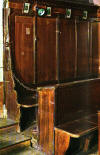 The
spot of the stigmatization of Padre Pio
The
spot of the stigmatization of Padre Pio 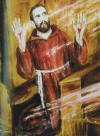
It all happened the morning of September 20, 1918, between 9 and 10. Padre Pio was praying in the choir after Mass. [22] He was kneeling on the upper row of stalls near the window,[23] on “the vicar’s bench”.[24]
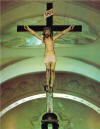
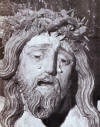
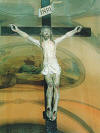

Padre Pio was alone. He saw a
“mysterious personage” bearing five wounds. He was terrified and fainted. When
he recovered his senses, his hands feet and side were dripping blood. The pain
was immense. He slowly got up and dragged himself, step by step on the wounded
feet, to his cell where he tried to control the bleeding and clean up.[25]
The Crucifix in the choir has four nails, two for the hands, and two for the
feet. Instead of the customary three.[26]
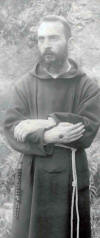
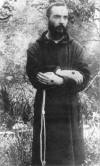
_small.jpg)

 The only picture of the wounds on the hands
The only picture of the wounds on the hands

Padre Pio did not tell anybody about it. How did people around him find out?
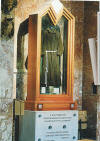
![]() The habit that Padre Pio was wearing at the time of the stigmatization
The habit that Padre Pio was wearing at the time of the stigmatization
Padre Paolino had gone to San Marco in Lamis to preach and confess in
preparation of the fest of St. Matthew.[27]
Brother Nicola da Roccabascerana was in the countryside in search of alms[28]
[29]
or in the kitchen[30].
The students had a vacation day and were staying in the backyard.
[31]
The first to notice the stigmata were the devout women in church.[32]
One of his spiritual daughters, Vittoria Ventrella, reported that “My sister
Filomena went to the convent on September 20, 1918, and was the first to notice
that the Padre had received the wounds, because she saw on his hands the red
marks similar to the marks that we see on the statue of the Sacred Heart. She
came home and told us.”[33]
Another spiritual daughter, Nina Campanile, went to the convent the morning of
September 21, to give Padre Pio an offering for a Mass to be said by Padre Pio.
In the sacristy, when she gave the offering she noticed a red mark on the back
of his hand. She said: “Padre, did you burn your hand?”
He did not answer. But when she tried to kiss the hand Padre Pio said:
“If you only knew the embarrassment you cause me!”[34]
When Nina reached home, she told her mother that Padre Pio has the stigmata like
St. Francis of Assisi.[35]
The next day, the 22nd, she went to the convent again and told the
superior: “Padre Paolino, do you know that Padre Pio has the stigmata?” Padre
Paolino smiled incredulously.[36]
Maria Campanile later committed to paper her memories of those days.[37]
Filomena Ventrella too went to Padre Paolino to inform him that Padre Pio
had the stigmata.[38]
Padre Paolino’s testimony: “I started thinking: “How can be possible that Padre
Pio has received the stigmata without me realizing it? I am always with him’. I
went in Padre Pio’s room without knocking at the door. He was writing at the
desk. When he saw me he got up. I asked him to continue writing. I got closer,
and first saw the wound on the back and on the palm of the right hand. Then I
saw the one on the back of the left hand. The same day I wrote to Padre
Benedetto, Provincial in San Marco La Catola, telling him what I had seen, and
asking him to come to San Giovanni Rotondo as soon as possible. To my
astonishment and disappointment he didn’t come. He sent me a letter where he
seemed not to give importance to what had happened. He only recommended me to
keep absolute silence over the issue.”[39]
[40]
Emilio da Matrice, at that time a fifteen years old student of the Seraphic
College, testified: “The morning of September 21, 1918, as soon as we approached
Padre Pio, we realized he had a wound on the palms of his hands, and was walking
with a certain difficulty. We learned only a few days later, from Padre Paolino,
that he had received the Lord’s wounds from[41]
the Crucifix in the choir.”
In a letter to Padre Benedetto on October 17, 1918, about a month after the
event, Padre Pio gave him a hint: “A mysterious individual wounded me all over.
Please come help me.
All my inside rains blood and I am forced to see it flow outside.
For pities sake I beg that ceases this torment, this condemnation, this
humiliation, this confusion!”
[42]
Padre Benedetto was in San Marco La Catola. He didn’t go to San Giovanni Rotondo
as requested, but sensed what had really happened, and wrote to Padre Pio on
October 19: “Tell me exactly what happened. I want know thoroughly everything,
under holy obedience.”[43]
Padre Pio wrote to Padre Benedetto under obedience on October 22:
“It was the 20th of last month and I was in the choir after Mass. It
was
the Friday after the feast of the stigmata of Saint Francis. Suddenly I was
wrapped in a sea of blazing light. In that light I saw a mysterious individual,
similar to the one I had seen the evening of August 5. He had hands, feet and
side dripping blood. From his wounds came rays of very bright white light that
penetrated my hands, my feet, and my side. They were like blades of fire that
penetrated my skin piercing, cutting, and breaking. I felt that I would die. The
pain was immense. The wounds were bleeding, especially the one on the side of
the heart. I had barely the strength to drag me to my cell to clean my clothes
all soaked in blood." Padre Pio concludes:
“Oh my God, how much confusion and humiliation I feel in having to show what You
have done in this poor creature of yours!”[44]
On December 20, 1918, Padre Pio wrote to his spiritual director Padre Benedetto:
“For several days I have been feeling like an iron blade penetrated the lower
part of my heart and extended transversally to the right shoulder. It gives me
an atrocious pain and doesn’t let me rest. What is this? This new phenomenon has
started after I saw the same mysterious personage that I saw on August five and
six and in September; of which I have written to you, if you remember, in other
letters.”[45]
According to the experts of mysticism this was the final seal of love, were
Padre Pio was completely transformed in a living image of Jesus.[46]
Padre Paolino da Casacalenda, the superior of Padre Pio, examined repeatedly the
chest wound, and reported in his memories: “The wound on the left side of the
chest has the form almost of an X. From that fact, one has to deduct that the
wounds are two.”[47]
The wounds created uneasiness in Padre Pio and in the friars. Padre Pio had to
continue his daily routine with the student of the seraphic college, while
dealing with the excruciating pain and the dripping of the blood. He started
wearing a green shawl trying to hide the hands under it. For mass he used a
vestment with extra-long sleeves, than he used full woolen gloves, and then half
gloves. He would remove them before the Canon and put them back after communion.
On the side wound he put a linen cloth, and on the feet he started
wearing socks. Padre Pio’s humility, simplicity and obedience were unchanged. He
would say to Padre Agostino: “Pray and have people pray for my conversion.”[48]
He went through desolation, aridity and scruples. “I see only darkness in my
soul. Who knows if God is happy with me.”[49]
On March 3, 1919 Padre Benedetto examined the wounds and sent a letter to Padre
Agostino: “They are real wounds, perforating the hands and feet. I have also
observed the side wound: it is a real gash that bleeds continuously either blood
or serum.”[50]
On April 24, 1919 Padre Benedetto informs the Padre Generale in Rome, explaining
what he had seen, and that he had not informed him before, because of the
sensitivity of the issue.[51]
The friars had no idea if the wound could be infected or contagious, since Padre
Pio had been diagnosed in the past as probably having tuberculosis. And the
Spanish fever was still raging or. An answer could come only from doctors.[52]
On May 1, 1919 Dr. Angelo Maria Merla was the first doctor to see Padre Pio
after he received the wounds. He was the town’s doctor, and also the mayor of
San Giovanni Rotondo. He went to the convent by request of Padre Paolino di
Tomaso da Casacalenda, the Padre Superior. He declared that the lesions were not
the result of tuberculosis, but that he could not say with any certainty what
caused them without extensive tests.[53]
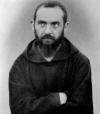
On May 15 and 16, 1919, Prof. Luigi Romanelli, head physician of the Hospital in
Barletta, by disposition of Padre Benedetto di San Marco in Lamis, Provincial
Superior of the Capuchins, did a physical on Padre Pio, examining the wounds. He
wrote a report that was sent to the Superior General in Rome.[54]
He wrote in his report: "The lesions on the hands are covered by a red brown
membrane, without bleeding, no edema and no inflammation of the surrounding
tissues.
The pigmented areas are membranes covering a hole. There was no bone resistance.
I am certain that these wounds are not superficial because, putting my thumb in
the palm of the hand, and the index finger on the back, and applying pressure, I
have the exact perception of a void existing."
[55]
“The wounds on the feet are circular, with a diameter of about 1 ½ inches,
covered with red lucent membranes, with sharp edges and surrounded by normal
tissue. They are located in the area of the second metatarsal bone.[56]
“On the left side of the chest, in the area of the sixth intercostal space,
there is a linear slash wound of about three inches, leaking out arterial
blood.”[57]
"The etiology of the lesions of Padre
Pio is not natural. The agent producing those lesions needs to be searched, make
no mistakes, in the supernatural. The fact in itself it's a phenomenon that
cannot be explained with the sole human science."[58]
[59]
[60]

In 1919-1921,Cardinal Augusto Silj, Prefect of Apostolic Signature, the Supreme
Tribunal of the Holy See, visited with Padre Pio several times, each time
expressing a very positive opinion to Pope Benedict XV.[61]
July 1919: Dr. Amico Bignami, professor of medical pathology of the University
of Rome, an atheist, examined Padre Pio by disposition of Padre Venanzio da
Lisle, Superior General, and of Padre Giuseppe da Persiceto, General Procurator
of the Capuchin Order. On July 26, 1919 he gave a written report of his
examination.
"The lesions on the hands, feet and side can be explained as unconsciously
self-produced by autosuggestion, and kept artificially with repeated
applications of tincture of iodine." He also stated: “I do not understand how
these wounds have persisted for nearly a year now without getting better or
worse.” Bignami also commented: “The expression of Padre Pio’s face is full of
goodness and sincerity and leads me to the positive exclusion of a simulation”.[62]
[63]
Bignami also ordered the wounds bandaged and sealed for eight days under
supervision of a sworn committee. When the bandages were unsealed and removed
eight days later “the wounds remained the same.”[64]
[65]
[66]
The committee was composed of Padre Paolino da Casacalenda, Padre Basilio da
Mirabello Sannitico, and Padre Ludovico da San Marco in Lamis. Padre Paolino
wrote in his memories: “I am particularly grateful to Dr. Bignami. Without his
order I would never had a chance to see the wounds. I was particularly impressed
by the side wound. It has almost a form of an X. That means that they are two
wounds.” In fact it was consequence of two separated mystical events: the
transverberation of August 5, 1918, and the stigmatization of September 20,
1918.[67]
On October 9 and 10, 1919, Dr. Giorgio Festa, a surgeon in private practice,
well known in Rome at the time, examined the wounds by disposition of Padre
Venanzio da Lysle, Superior General of the Capuchin Order.
He made three examinations. The last was in 1925.[68]
[69]
On October 28, 1919, Dr. Festa, back in Rome, wrote a report of his examination,
and gave it to the superior general of the Capuchin order.
“In the palm of the left hand there is a circular lesion a little less than 1
inch in diameter. The lesion has a red brown color and is covered by a blackish
crust. The lesion doesn’t seem very deep. The back of the left hand has a lesion
similar to the one on the palm . The lesions on the right hand have the same
characteristics of the left hand.
The dorsal and plantar sides of the feet have circular lesions similar to the
ones on the hands. Applying a light pressure on the lesions elicits a sharp
pain. While examining the lesions ooze serum and blood. The skin surrounding the
lesions shows no signs of edema, infiltrate, or inflammatory reaction.
Le lesion on the left side of the chest, transversal, about two fingers below
the nipple, has the form of a cross, with the long arm measuring about little
less than three inches, and the short arm about 1 ½ inches. The lesion is
superficial and still emits drops of blood, more than the other lesion.
The lesions appeared all together on September 1918, 13 months ago, and show the
same freshness as they had just appeared. In all this months they have not shown
any tendency to cicatrization.
My opinion is that they were not originated by a cutting object or by applying
chemical substances. The action of chemicals would have influenced also the
surrounding tissues, which are normal. Padre Pio has applied iodine every couple
of days to limit the loss of blood. However he hasn’t applied any for more than
3 months, by disposition of his superiors, and the lesions present the same
characteristics as before.
My conclusion is that the lesions and the hemorrhage of blood have an origin
that our knowledge is very far from explaining. The reason for them is well
above the human science.”[70]
[71]
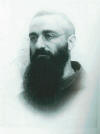 Padre Pietro da Ischitella
Padre Pietro da Ischitella
About the depth of the lesions, dr. Festa wrote that Padre Pietro da Ischitella,
the provincial superior had observed the lesions few months after the event and
had clearly the impression that the lesions went through the whole hand. Dr.
Festa continued: “I have personally questioned Padre Pietro da Ischitella, and
he told me verbatim: ’If a superior authority asks me I can declare and confirm
swearing that looking at the wound from the palm side one can easily see
through, recognizing a writing or an object positioned on the other side.’ “[72]
Dr. Andrea Cardone from Pietrelcina, who was friend and physician of Padre Pio
for many years, testified in 1968: “In both hands exist holes a bit larger than
half inch, passing through the palm of the hands to the other side; so that one
could see light passing through. And with pressure the fingertips of my thumb
and pointer touched each other.”[73]
In July 1920 the professors Giorgio
Festa and Luigi Romanelli did
follow up examinations of the wounds.
They did not perceive any interruption in the bones of the hands and of the
feet.[74]
Reported by Dr. Festa: A colleague of mine asked Padre Pio : "Why the lesions
are here and not in other parts of the body?" Answer: "You are a doctor. You
should tell me why they should have been in other parts of the body and not
here."[75]
[76]
[77]
The colleague of dr. Festa was dr. Bignami.[78]
[79]
Dr. Alberto Caserta of Foggia did x-rays of the hands of Padre Pio on October
14, 1954. The radiographs did not show interruptions in the bones.[80]
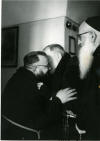
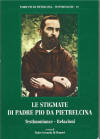 Padre Gerardo greeting Padre Pio, and one of his books
about the stigmatization of Padre Pio
Padre Gerardo greeting Padre Pio, and one of his books
about the stigmatization of Padre Pio
Regarding the chest wound, Padre Gerardo Di Flumeri has collected 14
descriptions of the direct observations of the examining physicians and of the
friars in contact with Padre Pio. They vary from a linear wound to one X shaped.[81]
Intigrillo: “The lesion on Padre Pio’s side will always be the subject of
discussion, with regard to both shape and exact position.”[82]
On November 19, 1919, the Cardinal Pietro Gasparri, Secretary of State, wrote to
the superior of the Capuchins, to recommend the Rosi family, who wanted to
confess and receive the Communion from Padre Pio, and also to ask him to pray
for the Pope’s intentions and for his own. He also asked for some little object
from Padre Pio for his niece Antonia Veda.[83]
[84]
[85]
Costa
In 1919, Mons. Alberto Costa, bishop of Melfi and Rapolla after visiting with
Padre Pio he wrote: “I am convinced of the holiness of Padre Pio. His life is
totally consecrated to the glorification of God and the conversion of the
sinners. My impression can be boiled down to one: to that of having talked to a
saint.”[86]
[87]
On March 24-27, 1920, Archbishop Anselm Edward Kenealy, of Simla, India, who was
himself a Capuchin and a prelate, examined Padre Pio by request of Pope Benedict
XV. Mons. Kenealy was known to be skeptical regarding mystical phenomena. He
spent five hours with Padre Pio.[88]
He reported: “I wanted to see the wounds of Padre Pio because I am resistant to
believe in things if I have not seen them with my own eyes. I went, I saw, I was
conquered (Veni, Vidi, Victus sum). I
am deeply convinced that we have a true saint here. The Lord, with the five
wounds of the Passion has given him great gifts, and he is completely at ease.
If he knows how to suffer, he also knows how to laugh.”[89]
[90]
[91]
On May 20, 1920, not completely satisfied, the pope sent archbishop Bonaventura
Cerretti, secretary of the Congregation for Extraordinary Ecclesiastical
Affairs, who’s Prefect was Cardinal Pietro Gasparri, to examine Padre Pio. He
reached the convent on May 24. Padre Onorato wrote that Cerretti came dressed as
a simple priest, showed the letter of the Holy Office and his episcopal cross,
and asked to examine Padre Pio. He was deeply impressed, wrote in the guest book
an expression of admiration, asked the prayers of Padre Pio, and gave the Pope a
very positive evaluation.[92]
[93]
Bishop Angelo Poli (or Police), apostolic vicar of Allahabad, India, visited
Padre Pio in October 1920. He wrote on November 2, 1920: “I came, I saw, and I
was conquered. Not the slightest doubt remains in me: the finger of God is here
(Digitus Dei hic est). Seeing Padre
Pio one feels overwhelmed by the presence of supernatural, and at the same time,
his natural simple attitude inspires confidence.”[94]
[95]
[96]
On February 17, 1921, Padre Pio expressed in a letter to Mons. Poli his desire
to become a missionary: “… I have made persistent pressure on my director to let
me be one of your missionaries, but he finds that I am unfit for it.”[97]
On April 18, 1920. Padre Agostino Gemelli, Franciscan friar, physician and
psychologist, went to the Convent. He said: "Padre Pio I came for a clinical
exam of your lesions." Padre Pio asked: "Do you have a written authorization?"
"No" replied padre Gemelli. "Then I'm not authorized to show them to you"
concluded Padre Pio. The conversation did not last more than two minutes: a few
words, no examination of the stigmata, and Padre Pio dismisses him. But the next
day Gemelli sends a personal letter to the Holy Office declaring the stigmata
“fruit of suggestion”, and two months later he sends a second one with specific
advice on the measures to take.[98]
Gemelli stated in a written report that he had examined Padre Pio, and described
in details the wounds, but it is certain that no such examination took place. He
also said the he had done a comprehensive psychiatric evaluation. Padre
Benedetto da San Marco in Lamis, who was present at the meeting, wrote a
detailed report, confirming that Gemelli hadn’t examined Padre Pio. Gemelli’s
criticism was instrumental for the measures taken by the Vatican against Padre
Pio.[99]
[100]
[101]
Gemelli’s report submitted to the Holy Office has never been released. In 1931
Cardinal Michele Lega told Padre Luigi da Avellino: “It was terrible. If you
could read it, it would change your mind about Padre Pio.”[102]
In later years Gemelli had “somewhat” changed his position about Padre Pio.
Gemelli died July 15, 1959. It is reported that Padre Pio told another friar
that he assisted and confessed Padre Gemelli in bilocation in his final moments.[103]
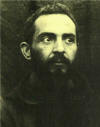
On July 12, 1920, Padre Luigi Besi, General Postulator of the Passionists, made
an apostolic visitation by disposition of Pope Benedict XV. He went unannounced.
When he reached Foggia by train, he was greeted by a Capuchin friar who told
him: “Padre Pio has asked for a friar to go to Foggia and pick up a Passionist
who had been sent by the Pope. I am here to accompany you to the convent.”[104]
[105]
Besi was impressed. He wrote that Padre Pio “was privileged by God, as was St.
but even more so.” (Gemma Galgani was
Passionist mystic nun who had died about twenty years before).
[106]
On July 20, 1920 prof. Giuseppe Bastianelli, the physician of pope Benedict XV
was sent personally by him to examine the wounds of Padre Pio. He visited with
Padre Pio on July 22 and examined the wounds. He gave a favorable report on the
supernaturalism of the case.[107]
[108]
In 1920, Mons. Alberto Valbonesi, titular bishop of Memphis, Egypt, a Vatican
employee, visited Padre Pio and was very favorably impressed. He said that the
interview with Padre Pio had ‘compensated me for years of pain.”[109]
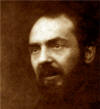
On September 7, 1920, Padre Roberto Nove di Bassano wrote that he had been to
San Giovanni Rotondo with a skeptical and indifferent attitude, but after
visiting with Padre Pio and closely observing his daily routine he had been
conquered by his serenity and simplicity, and had dropped all his preventions
against him.[110]
By summer the scene was one of pandemonium. The little church was invaded by
peasants, artist, writers, politicians, lawyers, doctors, journalists, curious,
fanatics, thieves, pickpockets, sick wanted to be cured, possessed wanting to be
freed.[111]
The church was not spared. People cut pieces from cassocks, chasubles, albs, and
anything that presumably had been used by Padre Pio, such as straws from chairs
were he had been seated. Whenever Padre Pio appeared in public they cut pieces
of his clothing.[112]
In April 1919 Padre Pio complained to Padre Benedetto that his breviary had been
stolen.[113]
[114]
People stayed around the convent for days, and since there were no hotels or
private homes outside the town a mile away, they slept under the stars, ate what
they could, and drunk well water.[115]
There was no sanitation and many were sick.[116]
The Capuchin friars deplored what was happening, including the publicity by the
press, forbidden by Canon Law.[117]
In the town of San Giovanni Rotondo things had changed dramatically since the
news about Padre Pio spread. One of the changes was that many faithful started
deserting the local parish and went to the convent for religious services. This
emptied the church in town and made some of the local clergy resentful. Don
Giovanni Miscio, don Giuseppe Prencipe and don Domenico Palladino accused the
friars of “putting Padre Pio on
display for the purpose of making money”. The Bishop of Manfredonia, Mons.
Pasquale Gagliardi, with jurisdiction over San Giovanni Rotondo, got informed,
noticed, and joined the action against the convent. They “bombarded the Vatican
with complaints about Padre Pio.” Gagliardi went to the Vatican deploring Padre
Pio’s horrible manner of hearing confessions” leaving the souls “in a state of
agitation”. He insisted: “Padre Pio is demon-possessed and the friars of San
Giovanni Rotondo are a band of thieves.” He added: “With my own eye I saw Padre
Pio perfume himself and put makeup on his face! All this I swear on my pectoral
cross.” He also state that Padre Pio habitually slept
in the friary’s guest room attended by young girls with whom he took
liberties. Gagliardi also charged that the friars were living in “unspeakable
luxury, and were raking in huge sums of money.[118]
In September 1919 a rumor spread that Padre Pio was going to be transferred. The
citizen made massive public demonstrations and stayed around to guard the
monastery day and night.[119]
[120]
On October 14, 1920 in a clash between opposed political parties on the square
of city hall in San Giovanni Rotondo, there were fourteen dead and eighty
wounded. The town got national attention. Padre Pio tried to promote
pacification between the parties.[121]
[122]
On June 21, 1921 a visiting priest was suspected by the people as the one
assigned to prepare for the transfer of Padre Pio, and they stormed the
monastery.[123]
[124]

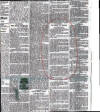
 The
Napoli newspaper "Il Mattino" reporting about Padre Pio
The
Napoli newspaper "Il Mattino" reporting about Padre Pio
For several months the stigmatization of Padre Pio was known only to few people.
Than he news spread, and pilgrims and curious arrived at the convent, from
Southern Italy, then from the whole Italy and from abroad.
[125]
On May 9, 1919 the “Il Giornale d’Italia” was the first newspaper to report
about Padre Pio.
On June 1, 1919 “Il Tempo” run a title “Il miracolo di un Santo” describing he
instantaneous healing of a soldier by Padre Pio. The article had been written by
Adelchi Fabbrocini. On June 3, 1919 the same paper “Il Tempo” titles “I miracoli
di Padre Pio a San Giovanni Rotondo”, reports some prodigies attributed to the
friar. Also reports that “at times his body reaches temperatures of 50 C (F 122)
as it has been observed with bath thermometers).”[126]
On June 20 and 21, 1919, the journalist, Renato Trevisani, on the Napoli’s
newspaper “Il Mattino”, in full page describes that “Padre Pio, ‘The Saint’ of
San Giovanni Rotondo, makes a miracle on the person of the town’s chancellor.”[127]
[128]
[129]
On June 19, 1920 the “Daily Mail” reports “extraordinary events happening daily
in San Giovanni Rotondo”, and describes how the wounds had been investigated by
the doctors and prelates“. On October 27, 1923 the Belgian newspaper “Le Soir”
describes the wounds, the examinations, the prodigies and the “very high fevers
of 48-50C “(118-122 F).
 The palace of the Holy Office in Vatican
The palace of the Holy Office in Vatican
Meanwhile the Vatican office of Inquisition, called at the time The Holy Office,
received contradictory information regarding what was going on in San Giovanni
Rotondo, about the nature of the wounds, the presumed holiness of the
stigmatized, and the behavior of the friars. The Holy Office was forced to take
a stand and initiated an exhaustive formal investigation.[130]
[131]
[132]
In 1920 the theologian Joseph Lemius of the Oblates or Mary Immaculate was
entrusted directly by the secretary of the Holy Office, Cardinal Rafael Merry
del Val.[133]
Lemius was asked a very precise question: “That measures, if any, should be
adopted by the Holy Office regarding Padre Pio da Pietrelcina.[134]
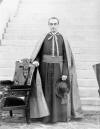 Cardinal Rafael Merry del Val, now Servant of God
Cardinal Rafael Merry del Val, now Servant of God
From the fall of 1920 to January 1921 he read the documentation available. In a
meeting at the Holy Office on January 21, 1921 he stated that without direct
examination on site nothing could be said for sure about the origin of the
stigmata.
Fr. Lemius suggested to send an Apostolic Visitor to be sent as a Qualificator,
to do a thorough investigation about Padre Pio’s moral, ascetic and mystical
character, focusing on humility and obedience, his way of dealing with women,
use of pharmaceutical products such as the carbolic acid he requested in
connection with the injections administered to the novices during the epidemic
of the Spanish fever.[135]
[136]
On April 26, 1921 the choice of the Holy Office fell on Msgr. Raffaello Carlo
Rossi, bishop of Volterra. He would have to answer the question on who really is
Padre Pio. He declined at first, than accepted the task. Mons. Rossi first went
to the Holy Office in Vatican were he examined Padre Pio’s file, full of praise
and criticism, then he went to San Giovanni Rotondo on June 14, 1921.[137]
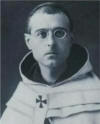 Padre Raffaello Carlo Rossi
of the Order of the Discalced Carmelites
Padre Raffaello Carlo Rossi
of the Order of the Discalced Carmelites
In 1921, The Holy Office ordered the first Apostolic Visitation concerning Padre
Pio. The bishop of Volterra Raffaello Carlo Rossi, future cardinal, was sent to
San Giovanni Rotondo. He started on June 14, 1921, and left after eight days.
Padre Pio was 34 years old. Mons. Rossi had formal interviews with two priests
of the local parish: archpriest Canon Mons. Dr. Giuseppe Prencipe and bursar
canon Domenico Palladino. He also interviewed the friar padres Lorenzo, Luigi,
Romolo, Lodovico, Pietro, and Cherubino. Last, he had formal interview and
examination of the wounds of Padre Pio.[138]
From Mons. Rossi’s written report: “Padre
Pio is a good religious, exemplary, accomplished in the practice of the
virtues.”[139]
"In conversation, Padre Pio is very pleasant; with his brothers, he is serene,
jovial, and even humorous."[140]
"The religious Community in which Padre
Pio lives is a good Community and one that can be trusted."[141]
"The very intense and pleasant fragrance, similar to the scent of the violet, I
have smelled it."[142]
"I have examined the monk's cell and
could find nothing that would cause such a scent. There was only plain soap."[143]
“He has attested in a sworn statement to never using, and never having used,
perfumes.”[144]
Padre Pio told Mons. Rossi under oath: "On September 20, 1918 I saw the Lord in
the posture of being on a cross, lamenting the ingratitude of men, especially
those consecrated to him. He urged me to
partake of his sorrows, and to work for my brothers’ salvation. I asked him what
I could do. I heard this voice: 'I
unite you with my Passion.' Once the vision disappeared, I came to my
senses, and I saw these signs here, which were dripping blood. I didn't have
anything before."[145]
Mons Rossi: "The stigmata are there: We are before a real fact that it is
impossible to deny."[146]
"I am fully in favor of their authenticity, and, in fact, of their Divine
origin."
"The future will reveal what today cannot be read in the life of Padre Pio of
Pietrelcina." The report, called “Votum on Padre Pio da Pietrelcina” was
completed on October 4, 1921 and given to the Supreme Congregation of the Holy
Office.[147]
“On the wounds I used iodine every once in a while, but a doctor told me that it
could irritate them even more. They had me to use petrolatum jelly when the
wounds would lose their scabs. It may be over two years that I have used nothing
at all.”[148]

 America
brother Bill Martin, later Father Joseph Pius
America
brother Bill Martin, later Father Joseph Pius
Padre Joseph Pius, Bill Martin before becoming a Capuchin friar, reported: “The
wounds were in the center of the palm, and the coagulated blood covered the
whole hand. The blood was always running out of the holes. It is true that if
you were very close and there was a light behind his hand you could see a light
shining through the holes. Mrs. Emilia Sanguinetti, said that when Padre Pio
celebrated Mass and held up his hands to bless people, she would see the light
through his hands. His feet were always very swollen. They were like melons
under his socks, one more swollen than the other. On the last day I did find
white crusts with a tone of pink, very pale pink, after last Mass on September
22. I took them away. When he died there were no scars.”[149]
Padre Pio to Mons. Rossi: “The wounds don’t always keep the same appearance. At
times they are more noticeable, at times less so. Sometimes they look like they
are about to disappear, but they didn’t, and then come back, flourishing again.”[150]
Mos. Rosi: “Do you swear on the Holy Gospel that you have not, directly or
indirectly, produced, nurtured, cultivated, preserved the signs?” Padre Pio: “I
swear! Quite the contrary! I would be very grateful if the Lord relieved me of
them!”
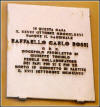 Sign on the house were Mos. Rossi was born in Pisa
Sign on the house were Mos. Rossi was born in Pisa
Mons. Raffaello Carlo Rossi, born in Pisa, Italy, was a religious of the Order
of the Discalced Carmelites. He served several Popes in many assignments in the
Roman Congregations, including the Holy Office. He was elected bishop of
Volterra and later Cardinal. Mons. Rossi saw Padre Pio’s holiness well before
many others who would follow him. He was the first to verify on behalf of the
Holy Office, the theological nature of the stigmata.[151]
He too, like Padre Pio, had an intense saintly life. Currently he is Servant of
God, and the process of sainthood is well under way.
Agostino, d. S. (2012). Diario. San
Giovanni Rotondo: Edizioni Padre Pio.
Ago12
Alessando, d. R. (Saint Pio of Pietrelcina.
Everybody's Cyrenean). 2010. San Giovanni Rotondo: Edizioni Padre Pio.
Ale10
Allegri, R. (1998). Padre Pio, un santo tra
noi. Milano: Edizioni Mondadori.
All98
Andrea, G. S. (2008). Padre Pio. L'ultimo
sospetto. Edizioni Piemme.
And98
Capuano, P. (2012). Con p. Pio: come in una
fiaba. Foggia: Grafiche Grilli.
Cap12
Casacalenda, P. P. (1978). Le mie memorie
intorno a Padre Pio. San Giovanni Rotondo: Edizioni Padre Pio.
Paol78
Castelli, F. (2011). Padre Pio under
investigation. The secret Vatican files. San Francisco: Ignatius Press.
Cas12
Chiron, Y. (1999). Padre Pio. Una strada di
misericordia. Milano: Figlie di San Paolo.
Chi99
DeLiso, O. (1962). Padre Pio. New York:
All Saints Press.
DeL62
Duchess Suzanne, o. S. (1983). Magic of a
Mistic. Stories of Padre Pio. New York: Clarkson N. Potter.
Duc83
Flumeri, G. D. (1995). Le stigmate di Padre
Pio, Testimonianze e relazioni. Edizioni Padre Pio.
Flu95
Giannuzzo, E. (2012). San Pio da Pietrelcina.
Il travagliato persorso della sua vita terrena. Book sprint edizioni.
Gia12
Ingoldsby, M. (1978). Padre Pio. His Life and
Mission. Dublin: Veritas Publications.
Ing78
Malatesta, E. (1999). La vera storia di Padre
Pio. Casale Monferrato: PIEMME.
Mal99
Mortimer Carty, f. C. (1973). Padre Pio the
stigmatist. TAN Books.
Mor73
Napolitano, F. (1978). Padre Pio of
Pietrelcina. A brief biography. San Giovanni Rotondo: Edizioni Padre Pio.
Nap78
Peroni, L. (2002). Padre Pio da Pietrelcina.
Borla.
Per02
Pietrelcina, P. P. (2011). Epistolario I
Corrispondenza con i direttori spirituali (1910-1922). San Giovanni Rotondo:
Edizioni Padre Pio.
Epist. I
Pietrelcina, P. P. (2012). Epistolario IV,
corrispondenza con diverse categorie di persone. San Giovanni Rotondo:
Edizioni Padre Pio.
Epist IV
Preziuso, G. (2000). The life of Padre Pio
between the altar and the confessional. New York: Alba House.
Pre00
Pronzato, A. (1999). Padre Pio, mistero
doloroso. Editore Gribaudi.
Pro99
Riese, Fernando da (2010). Padre Pio da
Pietrelcina crocifisso senza croce. San Giovanni Roronto: Edizioni Padre
Pio.
Fer10
Ruffin, C. B. (1991). Padre Pio: the true
story. Huntington, Indiana: Our Sunday Visitor, Inc.
Ruf91
Schug, J. O. (1987). A Padre Pio Profile.
Petersham, MA: St. Bedès Publications.
Sch87
Winowska, M. (1988). Il vero volto di Padre
Pio. Milano: Edizioni San Paolo.
Win88
[1] Gia12, 105
[2] Scg87, 112
[3] Gia12, 105
[4] Epist. I, 874
[5] Pre00, 87
[6] Sch87, 116-7
[7] Epist. I, 1054
[8] Gia12, 127
[9] Ruf91, 153
[10] Gia12, 203-4
[11] Cas11, 63
[12] Cas11, 223 and 204-5
[13] Cas11, 205
[14] Ruf91, 156
[15] Fer10, 133
[16] Gia12, 127
[17] Ale10, 84
[18] Epist. I, 1065
[19] Epist. I, 1068
[20] Epist. 1, 1068
[21] Duc83, 50
[22] Gia12, 128
[23] Per02, 248
[24] Ruf91, 155
[25] Per02, 248-252
[26] Ing78, 66
[27] Fer10, 134
[28] Fer10, 134
[29] Gia12, 127
[30] Per02, 252
[31] Pre00, 105
[32] Cas11, 154
[33] Ger95, 141-2
[34] Ger95, 143-4
[35] Pre00, 109-10
[36] Ger95, 143-4
[37] Ruf91, 163
[38] Ruf91, 154
[39] Pro99, 91-4
[40] Paol78, 70-75
[41] Cas11, 297
[42] Epist. I, 1090-1
[43] Epist I, 1091
[44] Epist. I, 1093
[45] Epist. I, 1106
[46] Gia12, 135-6
[47] Epist. I, 151
[48] Ago12, 58
[49] Ago12, 58
[50] Ago12, 341
[51] Gae08, 23-4
[52] Gia12, 140
[53] Paolino, 54-57
[54] Ger95, 147-151
[55] Ger95, 147-151
[56] Ger95, 147-151
[57] Ger95, 147-151
[58] Ger95, 147-151
[59] Fer10, 147-9
[60] Pre00, 112-4
[61] Pre00,124
[62] Fer10, 149-52
[63] Gia12, 145-9
[64] Ger95, 173-179
[65] Fer10, 153-4
[66] Pre00, 115-6
[67] Gia12, 150
[68] Mor73, 288-92
[69] Ger95, 179-273
[70] Mal99, 347-55
[71] Pre00, 117-8
[72] Fer10, 154-60, 170-1
[73] Fer10, 171
[74] Ger95, 173-179
[75] Win88, 71
[76] Ger95, 173-273
[77] Cap12, 393
[78] Del62, 79-80
[79] Win88, 71
[80] Ger95, tav, 17-20.
[81] Ger95, 10-22
[82] Cas11, 77
[83] Pre00, 123
[84] Mal99, 316
[85] Nap78,45-6
[86] Ruf91, 179-80
[87] Mal00, 317
[88] Pre00, 119
[89] Gia12, 175-6
[90] All98, 318
[91] Mal00, 319-20
[92] Pre00, 124
[93] Per02, 283
[94] Epist. IV,39 Note2.
[95] Ale99, 318
[96] Mal00, 318-9
[97] Epist IV, 40
[98] Cas11, 5
[99] Ruf91, 178
[100] Chi99, 152-3
[101] Pre00, 119-21
[102] Ruf91, 179
[103] Ruf91, 179
[104] Per01, 263-4
[105] Mal00, 319
[106] Pre00,
124
[107] Ruf91, 179
[108] Chi99, 153-4
[109] Ruf99, 179
[110] Chi99, 154
[111] Mal00, 326
[112] Gia12, 166
[113] Ruf91, 168
[115] Per03, 272
[116] Mal99, 263
[117] Pre00, 123
[118] Ruf91, 169, 183, 190
[119] Pre00, 123-4
[120] Per02, 282
[121] Chi99, 161-2
[122] Per02, 274
[123] Pre00, 124
[124] Per02, 282-3
[125] Fer10, 145-6
[126] Gia12, 143
[127] Cas11, 86
[128] Fer10, 146
[129] Mal99, 123
[130] Mal99, 134
[131] Gia12, 140
[132] Cas11, 5
[133] Cas11,64
[134] Cas11, 5
[135] Gia12, 204-5
[136] Cas11, 6
[137] Gia12, 206
[138] Cas11, 232
[139] Cas11, 27
[140] Cas11, 94
[141] Cas11, 132
[142] Cas11, 124
[143] Cas11, 125-6
[144] Cas11, 126
[145] Cas11, 202
[146] Cas11,107
[147] Cas11, 81-133
[148] Cas11, 201
[149] Sch87, 62-3
[150] Cas11, 231
[151] Cas11, 272